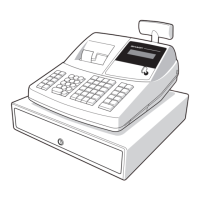
Do you have a question about the Sharp XE-A404 and is the answer not in the manual?
| Brand | Sharp |
|---|---|
| Model | XE-A404 |
| Category | Cash Register |
| Language | English |
Key operational and safety guidelines before use.
Battery charging recommendation for memory protection.
Identifies the main external components of the cash register.
Details the dual-station thermal printer, including its parts and operation.
Explains the function and settings of the mode switch and keys.
Shows the keyboard layout and defines the function of each key.
Describes the operator and customer displays, including indicators and messages.
Explains how to lock and unlock the cash drawer using the provided key.
Guides on selecting a proper location and unpacking the cash register.
Details the procedure for initial setup and programming of the register.
Instructions on removing the retainer and setting the print head lever.
Step-by-step guide for loading receipt and journal paper rolls into the printer.
Outlines essential programming for date, time, and tax before sales registration.
Lists optional functions that can be programmed for enhanced sales operations.
Checklist for preparing the cash register before commencing daily sales operations.
Lists the various sales entry functions available on the cash register.
Steps for closing the business day, including printing reports and securing the drawer.
Demonstrates a typical cash sale transaction, including key operations and receipt output.
Procedure for handling errors and safely exiting erroneous transactions by voiding.
Details on entering single items using department keys or code entry.
Instructions for using PLU codes for price lookup and sub-departments for item classification.
Guide to entering UPC/EAN barcodes and add-on codes for product identification.
Methods for entering multiple quantities of the same item efficiently.
Function for selling items normally sold in bulk, requiring specific programming.
Function for completing cash sales for single items automatically.
How to check unit prices for PLU/UPC items during a transaction.
Procedure for entering new UPC codes with their prices and departments.
How to view merchandise, taxable, and total subtotals during a transaction.
Process for completing a sale, including cash, check, charge, or mixed tenders.
How the register automatically calculates tax based on programmed rates and department status.
Procedure for manually entering tax amounts after item entries.
How to remove or void tax from taxable subtotals.
Method to temporarily change the tax status of departments or PLU keys.
Functions for discounts, premiums, refunds, and non-add codes.
Procedures for currency conversion, received-on-account, paid-out, and no sale transactions.
Programming and using the AUTO key for frequent transactions or reports.
How to void the most recent entry immediately after it's made.
How to void previous entries before finalizing a transaction.
Procedure to void an entire transaction after a subtotal has been calculated.
Steps for correcting errors found after transaction finalization, requiring manager intervention.
General steps for initiating the programming process using the manager key.
Instructions for setting the current time in 24-hour format.
How to set tax rates as percentages for automatic calculation.
Guide to programming tax calculation using a tax table based on sales ranges.
How to classify merchandise into departments and set their attributes like tax status.
Instructions for assigning unit prices and departments to PLU/UPC codes.
Setting commission rates for departments to calculate clerk commissions.
Configuring percentage, discount, and currency conversion keys.
Programming text labels for departments, items, and functions.
Setting the unique register number and the starting consecutive number.
Configuring miscellaneous keys, print formats, tax, and UPC code selections.
Settings for fractional treatment, time/date formats, error beeps, and receipt details.
Settings for power save mode, logo messages, HALO, and printer density.
How to read stored programming data, specifically the first programming report.
How to read stored programming data, specifically the second programming report.
Reading the report detailing programmed AUTO key sequences.
Reading the report on programmed thermal printer density settings.
Reading reports related to PLU/UPC code programming and data.
Overview of X (read) and Z (reset) reports, their purposes, and mode switch positions.
Details on various sales reports including full sales, department, and clerk reports.
Overview of functions enabled by using an SD memory card with the cash register.
Explains common SD card error messages and the corresponding corrective actions.
Step-by-step guide on how to insert and remove SD memory cards.
Procedure for formatting a new SD memory card before use.
How to save all register data to an SD card and restore it later.
Procedures for writing and reading programming data to/from an SD memory card.
How to write daily and periodic sales data onto an SD memory card.
Describes register behavior and recovery after a power failure.
Troubleshooting steps for printer errors like paper empty or head up.
Important precautions for handling the printer mechanism and print head.
Guidelines for proper handling and storage of thermal paper.
Instructions for removing and installing receipt and journal paper rolls.
Procedure for clearing paper jams from the printer mechanism.
Instructions for cleaning the printer's print head to ensure clear printing.
How to detach and remove the cash drawer and its till.
Method for manually opening the cash drawer in case of power failure or inoperability.
Instructions for installing a protective spill-proof cover over the keyboard.
Troubleshooting guide for common problems before contacting technical support.
A table listing error messages, their causes, and recommended actions.
How to void the most recent entry immediately after it's made.
How to void previous entries before finalizing a transaction.
Procedure to void an entire transaction after a subtotal has been calculated.
Steps for correcting errors found after transaction finalization, requiring manager intervention.
